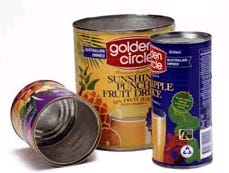Survey: Consumers underestimate benefits of canned foods
January 30, 2014

Canned food
Food packaged in steel cans can be just as nutritious (and sometimes more nutritious) than fresh and frozen varieties, yet many Americans surveyed on behalf of the Canned Food Alliance(1) mistakenly believe otherwise. Less than half (46 percent) of those surveyed recognize that canned foods count toward the government's recommended dietary guidelines. Furthermore, nearly 40 percent of consumers believe that canned foods are less nutritious than frozen, and nearly 60 percent believe that they are not as nutritious as fresh foods.
"The perception that food packaged in cans is different and less nutritious than fresh and frozen varieties is inaccurate," says Rich Tavoletti, executive director of the CFA. "The fact is canned foods deliver affordable, accessible and convenient nutrition, helping American families prepare and enjoy nutritious meals that taste great."
As a National Strategic Partner with the USDA Center for Nutrition Policy and Promotion Nutrition Communicators Network—the public/private group working to promote the Dietary Guidelines for Americans—the CFA is committed to educate consumers about canned food nutrition.
The CFA commissioned a consumer survey to better understand consumers' attitudes and perceptions of canned foods to help inform those efforts. The survey uncovered that, while the majority (84 percent) of Americans prepare or eat meals made with canned foods at least a couple times a month and one-third (34 percent) rely on them at least three times a week, many consumers do not appreciate all of the benefits canned foods offer.
Key survey highlights include:
•Canned foods count toward dietary goals: Less than half (46 percent) of Americans surveyed realize that canned foods count toward the U.S. Department of Agriculture's dietary recommendation goals. The new MyPlate food icon issued by the USDA provides guidance on how Americans should fill there plate for more healthful eating. Canned foods, including fruits, vegetables, beans, meat and seafood, are among the recommended ways that consumers can ensure they are getting a proper balance of nutrients.
•When it comes to nutrition, all forms count: Research shows many canned foods can be as nutritious and in some cases more nutritious than their fresh and frozen counterparts(2). Yet according to the survey, more than half (57 percent) of Americans disagree that canned food is as nutritious a fresh and more than one-third (37 percent) disagree that canned food is as nutritious as frozen.
•Canned foods and lower sodium are compatible: Only half (55 percent) of those surveyed know that canned foods can be low in sodium, despite the multitude of no salt, low sodium and reduced sodium options available on grocery shelves. Recent research involving canned beans demonstrates that rinsing and draining can reduce sodium levels per serving by 41 percent. Draining alone results in a 36 percent decrease.(3)
•Steel cans are a safe form of packaging: The steel food can is one of the safest forms of food packaging available, but only half (51 percent) of Americans surveyed realize it. In a 2005 review of nearly 4,500 food-borne-related outbreaks and more than 138,500 cases of illness, commercially produced canned fruits and vegetables did not directly account for a single food-borne outbreak.(4) The fact is, the steel food can is tamper resistant and provides an airtight seal to help keep food fresh and safe.
In addition to its consumer education efforts promoting ways canned foods can help Americans meet their dietary guidelines goals, the CFA works with dietitians, educators, policymakers and other influencers to ensure that the many benefits of canned foods are understood.
"The canned food industry is dedicated to helping American consumers, government agencies and schools serve up nutritious meals that are affordable and easy to prepare," Tavoletti says. "The CFA believes that all forms of foods—canned, fresh, frozen and dried—can and should have a place on America's tables and in school lunchrooms."
For more information about the canned food research, resources, the canning process, family mealtime solutions, recipes that use canned food and more, visit www.Mealtime.org.
(1) Canned Food Alliance telephone survey of 1,009 American adults conducted by CARAVAN Survey September 8-11, 2011. Margin of error +/-3.1 percent.
(2) Rickman, J., Barrett, D. and Bruhn, C. "Nutritional comparison of fresh, frozen and canned fruits and vegetables." Journal of the Science of Food and Agriculture, Vol. 87. Issues 6 and 7. April and May 2007.
(3) R. Duyff, J. Mount, J. Jones. J of Culinary Science and Technology, Vol 9, Issue 2; 2011.
(4) Center for Science in the Public Interest Outbreak Alert: Closing the Gaps in Our Federal Food-Safety Net, Nov. 2005.
Source: Canned Food Alliance
.
About the Author(s)
You May Also Like


